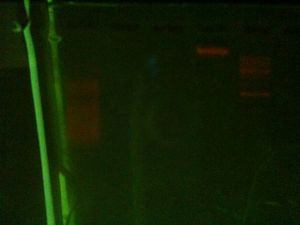Project:Plant species testing
We aim to extract DNA from plants, then PCR out a sequence and run it on a gel to test and refine our DNA extraction / PCR technique. First project is to test for peas. Inspiration and primers are in this paper. We are using two methods of extraction. 1st attempt with a chelex protocol, 2nd with alcohol precipitation. If you're trying to repeat any of these and not sure about the procedure, see the links on the front page.
Chelex extraction method - 17 and 18/7/12
Extraction (From this paper - we also have full text available):
- 'Homogenize' (mush) approx 40 mg pea with a pestle in 300ul of 5% chelex solution for 1 min
- Finger vortex for 10s then boil for 5 mins, then vortex again for 10s. (Hot plate lost heat in the middle so we boiled for 8 mins)
- Centrifuge for 1 min - recover supernatant and use as template
PCR:
- Prepare sample with 12.5 ul of Taq ready mix, 2 ul of each primer, 3 ul of template, and 5.5 ul of dH20.
- Denature at 96°C for 5 mins
- 40 cycles of D = 96°C for one minute, A = 58°C for 30 seconds, E = 72°C for one minute.
- Put paraffin on top after 5 mins (should have been before start)
Electrophoresis:
- Electrophoresed for 1 hr on an 100ml 1% agarose gel - started at 80V, settled at around 130V
- Visualised under UV light through orange filter - did not see any bands from the template, but ladder was visible, indicating PCR failed.
Repeat without PCR: 21/7/12
- Extraction: same procedure, but started with approx 50 mg of pea in 600ul chelex. (This is much more reactant than in the paper and a waste of chelex, but our scale only goes down to 100mg. Would be good to get a smaller one.)
- Electrophoresis: same procedure but used 0.5% instead of 1% agarose solution as we are running genomic DNA not PCR product.
Saw a faint, blurry band, running ahead of the ladder. Not sure what this is, as genomic DNA should be behind the ladder if not still in the well.
Repeat without PCR: 30/7/12
- Bashed peas into paste in a glove
- Placed a 1/2g of sample of template in 250 ul of chelex 5%
- Incubated at 56°C for 30 mins, with periodic vortexing, the 94°C for 10 mins
- 10 ul of supernatant visualised on 1% agarose gel, together with a sample containing only loading dye, a sample containing only chelex, and a sample from Will's first chelex extraction of 17/7.
Chelex only and loading dye only samples had no bands - so they are not contaminated with DNA. All pea samples showed a band running ahead of the ladder, becoming more diffuse over time. Conclusion: we think DNAses may be affecting the sample, cutting the DNA into small pieces.
Precipitation extraction method: 17/7/12, 24/7/12
- Blend peas with salt and detergent according to this protocol. Sieve.
- Incubate for 15 mins at 60°C (optional step that we didn't take)
- Centrifuge - recover supernatant
- Add proteinease K (100 ul of 1mg / ml solution to 300 ul of pea template) - incubate for 1 hr at 50C (action of proteinase k) then 94 C for 10 mins (inactivation of proteinase K)
- Add 100% ethanol, store at -20° overnight (actually for a week) for DNA to precipitate
- We observed white particles on the side of the tube which we assumed to be DNA, but no white strings, which is what we were expecting
- Centrifuge for 30 mins to make DNA form pellet at bottom of tube. Unclear if pellet had formed, but removed supernatant and resuspended in H2O anyway.
- Skipped PCR and ran genomic DNA on a 40mg agarose gel - as with chelex extraction, saw a faint blurry band running ahead of the ladder, and a small amount of stain in the well.
Conclusion: none of the runs prove we have DNA in the gel, indicating our extractions failed.
Repeat without PCR (30/7/12):
- 2 peas liquified, a few grains of salt and a drop of washing up liquid added
- Incubated at 56°C for 15 mins
- Centrifuge for 5 mins - recover 80 ul of supernatant.
- Add proteinease K (25 ul of 1mg / ml solution to 80 ul of pea template) - incubate at 50°C for 10 mins (action of proteinase k) then 94 C for 10 mins (inactivation of proteinase K)
- Add 70% isopropanol, store at -20° overnight.
- Centrifuge at 5000rpm for 40 mins. Isopropanol removed, pellet air dried for 20 mins, then resuspended in autoclaved H2O.
- 23ul of sample + 2ul of loading dye/glycerol mix electrophoresed at 80V for 30 mins. No staining observed.
From right:
- 1: 250-10000bp ladder (from hackspace). Ladder key
- 2: Chelex extraction from 17/7
- 3: Isopropanol extraction from 30-31/7
- 4: Isopropanol extraction from 30-31/7
- 5: Sample of liquified pea with no other reagents added apart from autoclaved water.
Conclusion: Isopropanol extractions failed because pellet contained too much plant matter - did not filter properly.
Liquified pea gives an easily visible smear. Chelex extraction behaved as last time.
Repeat without PCR (1/8/12):
- 5.3 grams of crushed pea added to 20ml of distilled, sterile water and a shake of salt. Solid removed and 3ml of detergent added
- Shake of meat tenderiser added to break down proteins
- Centrifuged and supernatant removed - solids discarded.
- 5ml of 70% added to 10ml of template for precipitation
- Interface removed and as much liquid as possible removed from this
- Pellet dried at 60°C in thermocycler.
- EDIT - what happened then...? No evidence on list.
